Use a NDA with Independent Contractor Agreements
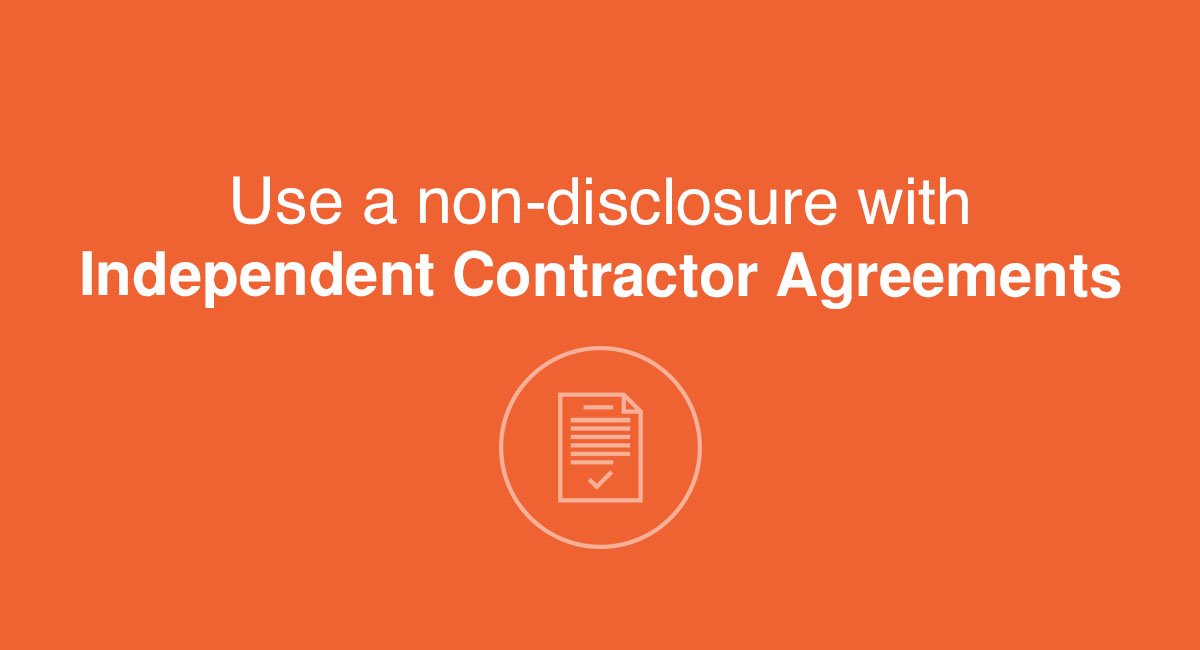
Hiring independent contractors instead of permanent employees have become a more common practice in recent years, especially due to the uncertainty of the economy and the changing nature of the workforce.
An independent contractor defers from a traditional employee in that the contractor is normally hired for a specific project or time period and he or she is liable for their own unpaid holidays and taxes and not entitled to employee benefits.
The contractor is also more independent, self-directed and is allowed to work for several different employers.
Contents
The Independent Contractor Agreement
Although it may not be legally necessary, when you’re deciding to hire a contractor, it’s always a good idea to formalize your working relationship using an independent contractor agreement.
An independent contractor agreement allows you to put any verbal terms that you agree in writing, helps you to avoid any nasty misunderstandings and also, is a clear declaration that the person you’re paying to work for you is not an employee but is a contractor.
There are some important elements to include in any independent contractor agreement.
Declaration of independent contractor status
One of the most important reasons why you should create this type of agreement with your contract is so that you can state expressly that the other party is being hired as an independent contractor and not as an employee.
Here is an example of a clause taken from ATRI’s Independent Contractor Agreement:

Description of the services to be performed
It’s important to state the exact services that you’re expecting from the contractor. Include the scope of work and how the services are to be performed.
ATRI’s website provides an example of such a clause:

If the contractor intends to use subcontractors, this should be stated in the agreement too.
Agreed payment amount and schedule of payment
There is nothing that can get nastier between parties than a misunderstanding of what the payment amount actually is and when it is to be paid.
Specify whether the payment is an hourly rate, a lump sum at the end when all work is completed or payment in stages.
Here is an example of a payment and compensation clause from Chapman University’s website:

Another example:
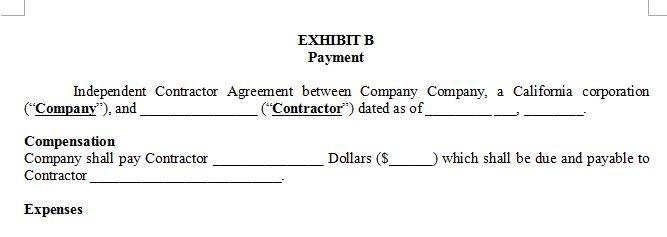
Time period for the completion of the work
You should include when you expect work to start and when it is to be completed.
If it’s a long project, divide up the work into stages and several deadlines. You could also include incentives to encourage the contractor to complete work before the scheduled deadline, such as a bonus for early completion of work or penalty for late completion.
Provision of necessary tools and materials
Be clear on who will be providing the necessary tools and materials for the performance of work. In some cases, this could be you as the employer but it could also be the contractor who’s responsible for providing his or her own tools.
For example, if you’re hiring a software developer, you may provide an office and computer where the developer can work.
If the developer is providing their own work tools, you would expect the developer to provide their own work space and computing equipment.
Work For Hire
If you’re hiring a contractor to create something with proprietary value for you such as a mobile app, website, graphic design or website development, it would be advisable for you to include a ‘work for hire‘ clause in your agreement.
A “work for hire” clause basically states that any copyrights, titles and interests that arise as a result of the work performed by the contractor in the course of your working relationship, will be transferred to you.
Here’s an example of a clause from Docracy:

Termination of contract
Although we often hope that all contractual relationships work out smoothly, sometimes unforeseen events crop up.
For example what if you found out that the contractor didn’t have the skills that you thought he or she had?
Your independent contractor agreement should provide how either party can terminate the contract, how much notice period is required, what happens with outstanding work and payments and what process the parties will follow in the event of a dispute.
A common provision for resolving conflict between the parties is that they are required to submit to an arbitration process instead of going to court. This is an example of a termination of clause taken from JUX Law Firm’s website:
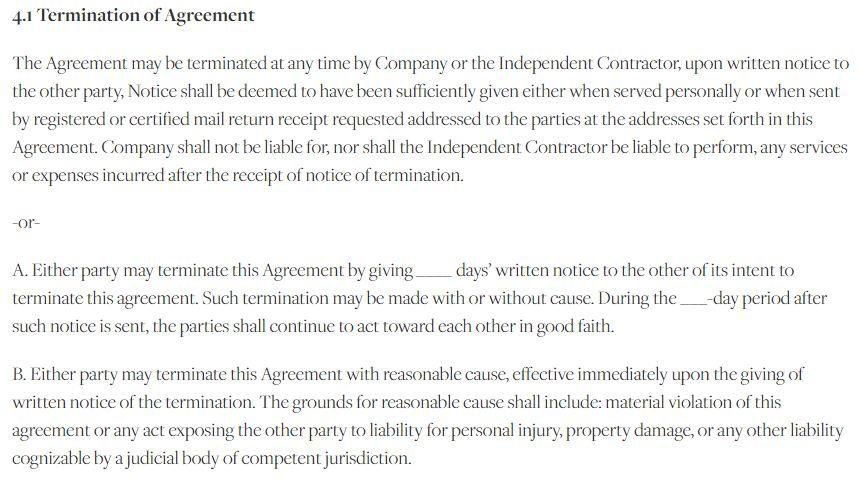
The Non-Disclosure
If you were going to have to reveal confidential information to the contractor so that she/he can perform your work, you may also consider using non-disclosure provisions.
One way that you can do this is to use a non-disclosure agreement (NDA) concurrently with the independent contractor agreement.
A NDA, just like the independent contractor agreement is a legally binding contract.
For example, if you were hiring her/him to develop an ecommerce website for you, you may need to reveal to her/him your list of suppliers and pricing model.
You could use the NDA agreement to require this website developer to keep any confidential information that you share secret and not to misuse the information without your permission.
Here’s an example of a confidentiality provision in an independent contractor confidentiality and non-disclosure agreement by ABWCCI:
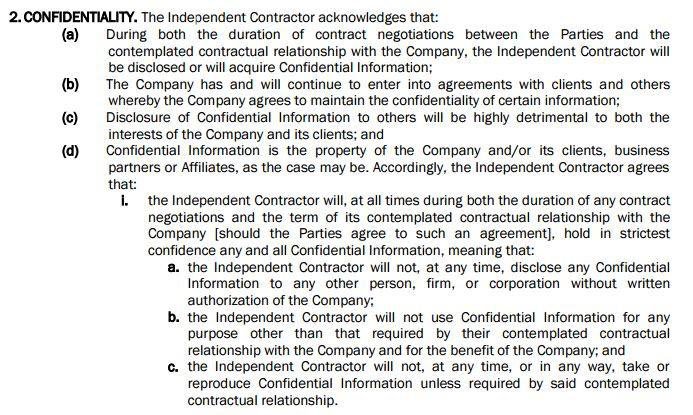
Confidentiality can extend to things such as documents, designs, sketches, analyses, source codes, marketing plans, manufacturing processes and technical procedures. Confidential information could also include your interface designs, wireframes, sketches, your hardware and software blueprints, functionality and mobile back-ends.
Here’s an example of a clause defining what would be considered confidential for the parties in a sample from the JUX law firm:
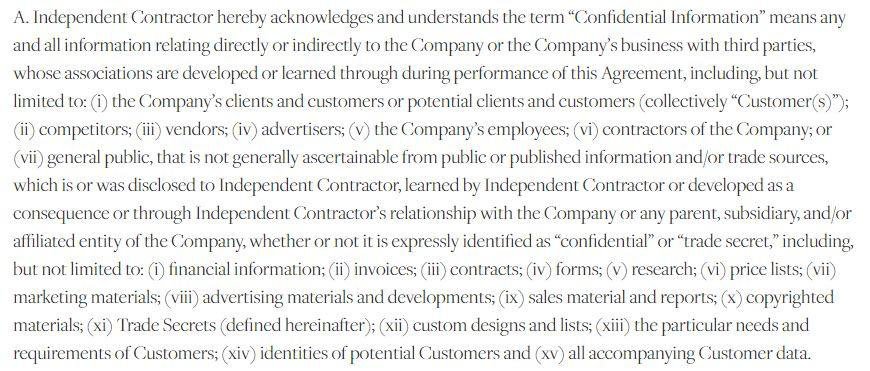
However, not all contractor relationships require non-disclosure clauses.
If you were hiring a non-contractor to come up with original ideas of his or her own and you were not going to be providing any sort of confidential information to the contractor, you won’t need a non-disclosure agreement.
In fact, insisting on non-disclosure protection in such a case would be superfluous.
For example, you may be hiring a contractor to do internet research online or data collection. In this case, there’s no sharing of confidential information that needs to be protected.
Remember that the more restrictions that you place on a contractor, the less attractive your work will be for the contractor to accept the work project.
In fact, some independent contractors like software developers refuse to work with parties that require non-disclosure agreements as they fear that they may be prevented from working with other clients that have similar ideas or projects in the future.
On top of this, adding unnecessary and unreasonable restrictions on your working relationship with an contractor actually weakens your agreement as courts are less likely to uphold an agreement that comes across as unduly anti-restrictive.
In the case of Everett J. Prescott, Inc. v. Ross, the court did not support clauses that restricted an employee’s freedom to look for future jobs.
Complete agreement or just a clause
If you do indeed have confidential information to share with your contractor and need to protect it, you can choose whether to include non-disclosure clauses directly into an independent contractor agreement or to draft a completely separate NDA agreement.
There are obviously pros and cons to both, depending on what you are trying to achieve.
Here are some factors for you to consider.
Simplicity
If the work that you need done through your contractor is pretty straightforward and simple, it may be easier just to incorporate the clauses specific to non-disclosure into the independent contractor agreement.
This is especially if the confidential information that you’re intending to disclose is limited in amount, importance and scope.
Restrictive clauses
If you intend to include non-competition and non-solicitation clauses in your independent contractor agreement, then it’s probably better to create a separate NDA agreement to include those specific clauses.
Non-competition clauses normally restrict a person from entering into similar employment or industries within a certain geographical area for a period of time.
Non-solicitation clauses prohibit a person from approaching your clients or poaching your employees. Certain states like California prohibit such restrictive clauses in agreements, except in certain circumstances such as the sale of a business’s goodwill and the dissolution of a partnership.
Nevertheless, other countries like the UK may enforce such clauses in order to protect legitimate business interests.
However, there’s always a possibility that a court may interpret a contract differently and decline to uphold clauses that are deemed to be too restrictive and if so, there’s the risk that the agreement will be declared invalid.
Because of this, if you intend to include more restrictive clauses in your agreement, you may be better off creating two distinct agreements. One for your more restrictive elements such as the non-competition clauses and another for your non-disclosure requirements.
Duration
Apart from confidentiality during the actual project itself, you could also require confidentiality to be extended after the completion of the project.
Depending on the importance and changing nature of the information, businesses may choose a shorter time duration such as confidentiality to be maintained for a year whilst others require confidentiality for up to five years.
The duration is something that you would need to work out with the contractor to ensure that you obtain adequate protection for your information but the duration is also reasonable.
There’s a special type of confidential information that courts have legally upheld to last indefinitely: trade secrets.
Trade secrets normally possess an inherent value from being kept secret and owners of trade secrets are required to fulfill certain requirements to protect their trade secrets including ensuring that reasonable steps are taken to protect the trade secret from being exposed to the public.
Famous examples are KFC’s secret recipe and Coca-Cola’s secret formula.
Although you should definitely take legal advice before you decide to share a trade secret with a contractor, if you were indeed going to have to share a trade secret in order for work to be performed, you should then insist on having a perpetual time duration of confidentiality for the trade secret.
Since most independent contractor agreements are limited in time duration, you may wish to draft a separate non-disclosure agreement with a perpetual time duration in order to make it clear that your trade secret has to be kept confidential indefinitely, even after your contractual relationship has ended.
In Silicon Image, Inc. v. Analogk Semiconductor, Inc. Silicon Image erroneously included a time limitation in its agreement and it subsequently was unable to enforce confidentiality after the time period ran out.
Governing law or jurisdiction
Different jurisdictions and different country’s laws can produce very different legal outcomes for different clauses.
By combining the independent contractor and non-disclosure objectives into one agreement, you’ll be forced to have one jurisdiction and one governing law rule over the entire agreement.
This may be fine if the governing law or jurisdiction have supportive positions for both the contractor and non-disclosure objectives that you’re trying to achieve but if not, it would be better if you separate the agreements.
In this way, you can use two different governing laws and jurisdictions to apply to the separate agreements.
Here is an example of a governing law and jurisdiction clause from Docracy:

Credits: Icon contract by Chameleon Design from the Noun Project.
Jan 30, 2017 | Non-disclosure Agreements | Other Agreements
This article is not a substitute for professional legal advice. This article does not create an attorney-client relationship, nor is it a solicitation to offer legal advice.